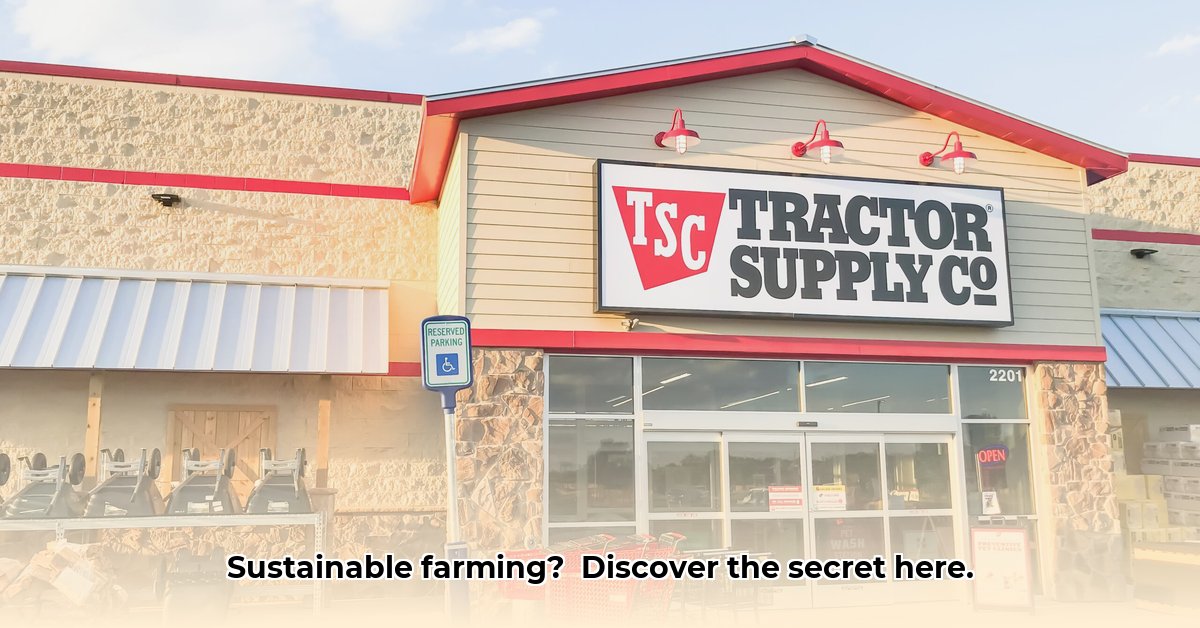
Tractor Supply Company Prior Lake: A Hub for Sustainable Agriculture?
Tractor Supply Company (TSC) in Prior Lake, Minnesota, presents itself as a convenient resource for local farmers and gardeners seeking sustainable solutions. But does its impact truly align with environmentally friendly practices, or is it merely a supplier of convenience? This article examines TSC's role, exploring its strengths and weaknesses, and offering actionable steps for enhancing its contribution to sustainable agriculture in the Prior Lake area. For example, consider options for electric fencing, like those found at electric fence supplies.
Assessing TSC Prior Lake's Contribution to Sustainability
TSC's accessibility and wide product selection – from seeds and animal feed to tools and equipment – undoubtedly increase the availability of sustainable options for local growers. However, its effectiveness hinges on several crucial factors. A critical aspect lies in the sustainability of its own supply chain. Are the animal feeds and fertilizers sourced responsibly? What about the packaging? Is it recyclable or biodegradable? Transparency in these areas is vital to understanding TSC's actual environmental footprint. Furthermore, the ultimate success depends on consumers utilizing those resources for sustainable practices, such as implementing water-efficient irrigation or employing cover cropping techniques. Merely offering the products isn't enough; knowledge and adoption are equally critical.
Do you find the current level of transparency regarding TSC's sustainable sourcing sufficient? What percentage of their products do you estimate are currently sourced sustainably? (This data is currently unavailable and would require additional research).
Empowering Sustainable Practices: A Collaborative Path Forward
To significantly amplify the positive impact, a comprehensive collaborative strategy involving several key players is essential.
Tractor Supply Company Prior Lake's Role
Enhanced Supply Chain Transparency: Conduct a comprehensive audit of your entire supply chain, assessing the environmental impact from sourcing to delivery. Publicly disclose this assessment to build consumer trust and demonstrate a commitment to sustainability. (Efficacy metric: A publicly available audit report would establish a baseline and track progress.)
Empowering Educational Initiatives: Offer regular workshops and seminars on effective and environmentally friendly farming techniques. Partner with trusted local agricultural experts to ensure the information is both accurate and engaging. (Efficacy metric: Measure workshop attendance and gather feedback on participants' perceived knowledge gain.)
Expansion of Sustainable Product Offerings: Significantly increase your range of organic and sustainably sourced products, clearly labeling them for easy identification. This should include organic seeds, sustainably produced fertilizers, and tools made from recycled or sustainably harvested materials. (Efficacy metric: Track the percentage increase in sales of sustainably sourced products.)
Embracing Renewable Energy: Invest in renewable energy sources, such as solar panels, to power the store, showcasing a commitment to sustainability beyond just product selection. (Efficacy metric: Report on energy reduction from renewable sources and cost savings.)
Responsibilities of Local Farmers and Gardeners
Informed Purchasing Decisions: Carefully consider your purchases at TSC, making deliberate choices aligned with your sustainability goals. Don't hesitate to seek guidance from TSC staff on making environmentally responsible purchases. (Efficacy metric: Could be measured through surveying farmers about their purchasing habits.)
Adoption of Sustainable Farming Techniques: Actively implement sustainable farming methods such as crop rotation, integrated pest management, and water conservation. (Efficacy metric: Could be assessed through on-farm audits or self-reporting by farmers.)
Leveraging Available Resources: Take full advantage of workshops and resources offered by TSC and other local organizations to expand your knowledge and enhance your sustainable farming practices. (Efficacy metric: Track participation in educational programs.)
The Consumer's Vital Contribution
Conscious Consumption: When shopping at TSC, prioritize organically produced products and those with minimal packaging. Supporting local and responsibly sourced food strengthens the entire sustainable food system. (Efficacy metric: Market research into consumer purchasing trends.)
Advocating for Transparency: Actively request more detailed information on product sourcing and sustainability initiatives from TSC. Let your buying habits reflect your values. (Efficacy metric: Measure the number of customer inquiries about sustainability.)
Supporting Local Producers: Seek out locally produced, sustainably grown food at farmers' markets and local grocery stores. (Efficacy metric: Track consumer spending habits in local markets.)
Local Government's Role in Fostering Sustainability
Strategic Partnerships: Collaborate directly with TSC to develop and promote local sustainability initiatives. This could involve joint sponsorship of educational programs or creating incentives for sustainable agriculture. (Efficacy metric: Measure joint program participation.)
Incentivizing Sustainable Practices: Offer tax breaks, grants, or other financial incentives to farmers and businesses that embrace sustainable agricultural methods. (Efficacy metric: Track the number of businesses and farmers taking advantage of these incentives.)
Investing in Sustainable Infrastructure: Develop and improve infrastructure that supports sustainable agriculture, such as enhanced water management systems or composting facilities. (Efficacy metric: Monitor infrastructure improvements and their impact on sustainable practices.)
Navigating Challenges: A Realistic Assessment
Implementing sustainable agricultural practices presents several inherent challenges.
| Risk Factor | Likelihood | Impact | Mitigation |
|---|---|---|---|
| Unsustainable sourcing practices | Medium-High | High | Rigorous supplier vetting; increased transparency; third-party audits. |
| Lack of consumer awareness | High | Medium-High | Joint educational campaigns; clear labeling and communication. |
| Competition | Medium | Medium | Focus on differentiation by emphasizing sustainability commitments. |
| Climate change | High | Very High | Promote climate-resilient farming practices; research and adoption of climate-adaptive methods. |
| Regulatory changes | Low-Medium | Medium | Continuous monitoring of regulations and proactive adaptation. |
The Regulatory Landscape: A Framework for Success
Understanding and adhering to local, state, and federal regulations governing organic certification standards, pesticide use, and other aspects of farming is crucial for long-term success in this area.
Conclusion: A Shared Vision for a Sustainable Future
Through collaborative action between Tractor Supply Company, local farmers and gardeners, consumers, and local government, Prior Lake can serve as a model for sustainable agriculture. This shared effort promises a healthier environment and a more vibrant agricultural community for the future. The commitment to sustainability is an ongoing process, demanding continuous effort and adaptation.